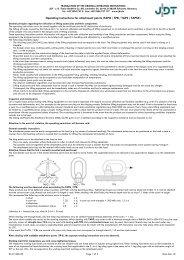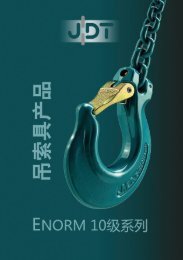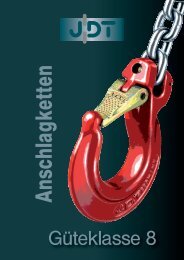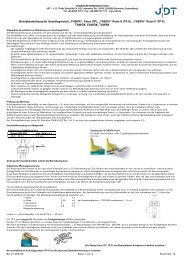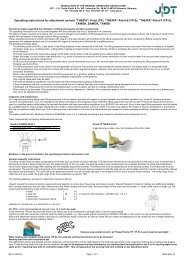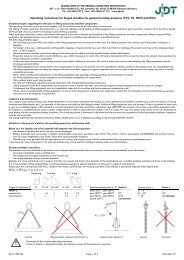You also want an ePaper? Increase the reach of your titles
YUMPU automatically turns print PDFs into web optimized ePapers that Google loves.
TRANSLATION OF THE ORIGINAL OPERATING INSTRUCTIONS<br />
<strong>JDT</strong> – J. D. Theile GmbH & Co. KG, Letmather Str. 26-45, D-58239 Schwerte, Germany<br />
Tel: +49 2304 757 0 Fax: +49 2304 757 177 www.jdt.de<br />
Operating and <strong>as</strong>sembly instructions for chains, chain slings and components for slings<br />
General principles regarding the utilisation of lifting accessories and their components:<br />
The operating instructions are to be stored together with the certificate and the EC declaration of conformity.<br />
The falling of loads, caused by the failure and / or incorrect utilisation and handling of lifting equipment or its individual parts constitutes a direct risk to the life or health of the<br />
people who are present in the danger zone of lifting processes.<br />
These operating instructions contain information with regard to the safe utilisation and handling of the lifting accessories and their components. Before using the lifting equipment,<br />
the <strong>as</strong>signed persons are to be briefed with regard to handling and utilisation by a qualified person.<br />
The following principles apply:<br />
- The Working Load Limit (WLL) (see label) of the lifting equipment must correspond to the load. The lifting equipment may not be used if the label is missing or is illegible.<br />
- No danger are<strong>as</strong> (e.g. crushing points, cutting points, trapping or impact points) may occur that may hinder or endanger the person carrying out the slinging process and / or<br />
the transport.<br />
- The b<strong>as</strong>e material and the constructive design of the load must be able to hold the applied forces without deformation.<br />
- Stress that leads to a non-uniform load distribution, e.g. which is caused <strong>as</strong> a result of an off-centre introduction of force must be taken into account when selecting the lifting<br />
accessories and their components.<br />
- In the event that extreme stress or strong dynamic strain (shock influences) may occur, this must be taken into account when selecting the lifting equipment and the working<br />
Load Limit (WLL).<br />
- The lifting equipment may not be used for the transportation of persons. No persons are ever permitted to remain present in the danger area of a suspended load.<br />
- The lifting equipment may not come into contact with acids and other aggressive agents. Attention must also be paid to the fact that acid fumes may occur in certain<br />
production processes.<br />
- Never make unauthorised amendments to the lifting equipment (e.g. grinding, welding, bending, and attachment of parts)!<br />
- The lifting equipment may not be exposed to any forbidden manipulation of temperature.<br />
- Only original replacement parts may be used.<br />
- The relevant additional regulations must be observed when transporting hazardous substances.<br />
- Lifting accessories and their components must be stored in such a manner that they are protected against being damaged and do not cause any danger.<br />
- If damaged, the lifting equipment must be immediately taken out of circulation and must undergo maintenance work.<br />
- When ready to be discarded, lifting accessories and their components are to be correctly disposed of. Attention: Any substances present that are hazardous to the<br />
environment (e.g. gre<strong>as</strong>es and oils) are to be disposed of separately.<br />
Attention: In the event of violation, the operating permission will become void.<br />
1. Working Load Limit and temperature use<br />
Table 1 ENORM grade 10 Working Load Limit (WLL) in t according to EN 818 and PAS 1061<br />
Nominal<br />
size<br />
Single-leg Two-leg 3- + 4-leg<br />
Endless chain<br />
sling choke hitch<br />
Endless chain sling Endless chain sling<br />
[mm] 0°-45° 45°-60° 0°-45° 45°-60° 0°-45° 45°-60° 0°-45° 45°-60°<br />
6 1 .4 2 1 .4 3 2 .12 2 .24 1 .6 1 .12 2 .3 1 .7<br />
8 2 .5 3 .55 2 .5 5 .3 3 .75 4 2 .8 2 4 .2 3<br />
10 4 5 .6 4 8 6 6 .3 4 .25 3 .2 6 .7 4 .75<br />
13 6 .7 9 .5 6 .7 14 10 10 .6 7 .5 5 .3 11 .2 8<br />
16 10 14 10 21 .2 15 16 11 .2 8 17 11 .8<br />
18 12 .5 18 12 .5 26 .5 19 20 14 10 21 .2 15<br />
22 19 26 .5 19 40 28 30 21 .2 15 31 .5 22 .4<br />
26<br />
Factor<br />
26 .5 37 26 .5 56 40 42 .4 29 21 .2 45 32<br />
symmetrical 1 1 .4 1 2 .1 1 .5 1 .6 1.1 (1.4)* 0.8 (1)* 1.7 (2.1)* 1.2 (1.5)*<br />
<strong>as</strong>ymmetrical 1 1 1 1 .5 1 – – – – –<br />
*In the event of appropriate usage – not with choke hitch/no sharp edges etc. – the values of the respective chain sling will<br />
apply.<br />
Table 2 grade 8 Working Load Limit (WLL) in t according to EN 818<br />
Nominal<br />
size<br />
Single-leg Two-leg 3- + 4-leg<br />
Endless chain<br />
sling choke hitch<br />
Endless chain sling Endless chain sling<br />
[mm] 0°-45° 45°-60° 0°-45° 45°-60° 0°-45° 45°-60° 0°-45° 45°-60°<br />
6 1 .12 1 .6 1 .12 2 .36 1 .7 1 .8 1 .25 0 .9 1 .9 1 .32<br />
7 1 .5 2 .12 1 .5 3 .15 2 .24 2 .5 1 .7 1 .25 2 .65 1 .8<br />
8 2 2 .8 2 4 .25 3 3 .15 2 .24 1 .6 3 .35 2 .36<br />
10 3 .15 4 .25 3 .15 6 .7 4 .75 5 3 .35 2 .5 5 .3 3 .75<br />
13 5 .3 7 .5 5 .3 11 .2 8 8 .5 5 .83 4 .25 9 6 .3<br />
16 8 11 .2 8 17 11 .8 12 .5 9 6 .3 13 .2 9 .5<br />
18 10 14 10 21 .2 15 16 11 .2 8 17 11 .8<br />
20 12 .5 17 12 .5 26 .5 19 20 14 10 21 .2 15<br />
22 15 21 .2 15 31 .5 22 .4 23 .6 17 11 .8 25 18<br />
26 21 .2 30 21 .2 45 31 .5 33 .5 23 .6 17 35 .5 25<br />
28 25 33 .5 25 50 37 .5 40 26 .5 20 42 .5 30<br />
32 31 .5 45 31 .5 67 47 .5 50 35 .5 25 53 37 .5<br />
36 40 56 40 85 60 63 45 31 .5 67 47 .5<br />
40 50 71 50 106 75 80 56 40 85 60<br />
45<br />
Factor<br />
63 90 63 132 95 100 71 50 106 75<br />
symmetrical 1 1 .4 1 2 .1 1 .5 1 .6 1.1 (1.4)* 0.8 (1)* 1.7 (2.1)* 1.2 (1.5)*<br />
<strong>as</strong>ymmetrical 1 1 1 1 .5 1 – – – – –<br />
*In the event of appropriate usage – not with choke hitch/no sharp edges etc. – the values of the respective chain sling will<br />
apply.<br />
In each individual c<strong>as</strong>e special attention h<strong>as</strong> to be paid to the maximum temperature which the components for slings are exposed to. The influence of higher temperatures on the<br />
working load limit (WLL) of various grades of lifting equipment is stated in Table 3. After cooling down to a temperature beneath 200°C, one can again work with WLL of 100 % for<br />
both grade 8 and grade 10 chain slings.<br />
BA 01 009 01 Page 1 of 3 Date Oct-11
Table 3<br />
TRANSLATION OF THE ORIGINAL OPERATING INSTRUCTIONS<br />
<strong>JDT</strong> – J. D. Theile GmbH & Co. KG, Letmather Str. 26-45, D-58239 Schwerte, Germany<br />
Tel: +49 2304 757 0 Fax: +49 2304 757 177 www.jdt.de<br />
Temperature range in °C WLL grade 8 in % WLL ENORM grade 10 in %<br />
minus 40°C – plus 200°C 100 100<br />
plus 200°C – plus 300°C 90 90<br />
plus 300°C – plus 400°C 75 75<br />
Notice: grade 8 and 10 lifting equipment may not be used at temperatures above 400°C.<br />
2. Assembly of the lifting accessories<br />
When <strong>as</strong>sembling chain slings, special attention must be given to the nominal size and grade. Every finished <strong>as</strong>sembled piece of slinging equipment must be labelled in<br />
accordance with the European Machinery Directive.<br />
2.1 Assembly of the clevis head <strong>as</strong>sembly system<br />
2.2 Assembly of the coupling <strong>as</strong>sembly system<br />
2.3 Assembly of the shortening elements<br />
See separate <strong>as</strong>sembly instructions<br />
The <strong>JDT</strong> components are coordinated to one another with regard to the nominal size<br />
and are labelled with the respective nominal size.<br />
- Introduce the chain into the respective clevis head.<br />
- Insert the bolt and secure with the locking pin. Use the locking pin only once.<br />
3. Utilisation of the sling chains<br />
The regulations of BGR 500, Chapter 2.8 / respective country-specific directives are to be observed when sling chains are used.<br />
Contrary to the <strong>JDT</strong> clevis head <strong>as</strong>sembly system, the components of the<br />
coupling <strong>as</strong>sembly system can be confound !<br />
Ensure correct nominal size and labelling during <strong>as</strong>sembly.<br />
The arrangement of the individual parts should only be carried out by qualified person<br />
(expert).<br />
- Assemble the m<strong>as</strong>ter link with marking tag.<br />
- Install the halves of the coupling into the m<strong>as</strong>ter link / terminal link respectively and<br />
into the chain.<br />
- Bolts and sleeves serve <strong>as</strong> a safety element and connection element of both halves<br />
of the coupling.<br />
- Push the bolt through the sleeve by hitting lightly with the hammer until completely<br />
driven in.<br />
3.1 Bringing into service – before the first time use<br />
Before the lifting equipment is used for the first time, it h<strong>as</strong> to be ensured that:<br />
- The lifting equipment exactly corresponds to the order;<br />
- The testing certificates are present (acceptance test certificate, declaration of conformity, etc.);<br />
- The labeling and working load limit (WLL) details on the lifting equipment correspond to the details on the test certificates (see Tables 1 and 2).<br />
3.2 Handling of the load<br />
Before each use, the lifting equipment h<strong>as</strong> to be inspected for evident defects or characteristics of wear. Proceed according to the maintenance guidelines in the event that<br />
damage is observed (see Point 5).<br />
- The weight of the load must be known.<br />
- The centre of gravity of the load must be known.<br />
- Chain slings are always to be deployed with a straight leg. They are not permitted to be twisted and must not display kinks or knots.<br />
- Lifting hooks must be secured with a latch.<br />
- The chains may not be pulled over sharp (radius ≤ chain diameter) edges if they are not protected. Edge protection must be provided in such a c<strong>as</strong>e or the working load limit<br />
(WLL) is to be reduced by 20 %.<br />
3.3 Multi-leg chain slings<br />
An angle of inclination between 15° and 60° must be present. When being used in a choke hitch, the working load limit (WLL) is to be reduced to 80 %.<br />
Generally, chain slings should only be used for their intended purpose. However, c<strong>as</strong>es occur in reality where not all individual legs are used at the same time. In such c<strong>as</strong>es, the<br />
working load limit is to be reduced according to Table 4:<br />
Table 4<br />
Type of chain sling Number of individual<br />
legs used<br />
Two leg 1<br />
three- / four leg 2<br />
three- / four leg 1<br />
Usage factor compared to the<br />
stated Working Load Limit (Table 1<br />
and 2)<br />
1 /2<br />
2 /3<br />
1 /3<br />
Individual legs that are not being used should be hung back into the m<strong>as</strong>ter link in order to avoid danger caused by the chain swinging or by unintended hooking during the lifting<br />
process.<br />
When dealing with <strong>as</strong>ymmetrical loads, the factors according to Table 1 or 2 respectively are to be taken into account.<br />
4. Storage of lifting equipment<br />
Lifting equipment not in use should be stored on a frame that is intended for this purpose. After usage, the equipment should not be left lying on the floor <strong>as</strong> it can be damaged<br />
there.<br />
The lifting equipment is to be protected against corrosion in the event that it is not expected to be used in the near future.<br />
In the event that chain slings with hooks remain on the crane hook without a load, the hooks are to be hung into the m<strong>as</strong>ter link.<br />
5. Inspection and maintenance<br />
On a regular b<strong>as</strong>is before being used, lifting equipment is to be closely inspected with regard to correct utilisation and faultless condition (e.g. screw fit, absence of strong corrosion<br />
and deformation, etc.), for example by the person carrying out the slinging process. Defective lifting equipment may not be used. It h<strong>as</strong> to be tested at le<strong>as</strong>t once a year by a<br />
qualified person whilst taking the relevant standards (EN 818-6) and trade <strong>as</strong>sociation regulations (e.g. BGR 500) into account. Every three years lifting equipment must be tested<br />
by a qualified person using a proper testing device in order to check that the product is free of cracks. The user must observe the results of the risk <strong>as</strong>sessment in accordance with<br />
the occupational safety directives. The re-testing period is shortened in the event that the products are exposed to critical operating conditions. Inspection records are to be kept.<br />
The testing coefficient (EC-Machinery Directive 2006/42/EC Point 4.4.1) is defined according to the standards DIN EN 818 ff. / PAS 1061 and / or DIN EN 1677 ff.<br />
BA 01 009 01 Page 2 of 3 Date Oct-11
TRANSLATION OF THE ORIGINAL OPERATING INSTRUCTIONS<br />
<strong>JDT</strong> – J. D. Theile GmbH & Co. KG, Letmather Str. 26-45, D-58239 Schwerte, Germany<br />
Tel: +49 2304 757 0 Fax: +49 2304 757 177 www.jdt.de<br />
In the event that the following defects occur, the lifting equipment is to be taken out of circulation immediately and sent for maintenance:<br />
- Labelling concerning working load limit or proof of identity of the lifting equipment is illegible or is missing.<br />
- Deformation of m<strong>as</strong>ter links, chain or components for slings (Figure 1).<br />
- Inadmissible wear or elongation of individual chain links is present for example, in the event that the nominal dimension of the inner length h<strong>as</strong> been exceeded by 5 %, which<br />
meet an outside elongation of 3 % (Figure 2).<br />
- Reduction of the mean chain link thickness at any point of >10 % (Figure 3).<br />
- Clear length differences in the chain legs when dealing with multi-leg chain slings.<br />
- Signs of a widening on the hooks, meaning for example noticeable incre<strong>as</strong>e of the hook aperture. The incre<strong>as</strong>e of the hook aperture may not be above 10 % of the nominal<br />
value (catalogue dimension “m” figure 4) or the hook safety latch may not be rele<strong>as</strong>ed (Figure 5).<br />
- Wear (reduction in thickness) on the hook b<strong>as</strong>e of ≥5 % (catalogue dimension “h” figure 4).<br />
- Damage such <strong>as</strong>: cuts, indents, grooves, linear cracks, excessive corrosion, discolouration caused by the impact of heat, bent or twisted chain links or other faults.<br />
- Reduction in bolt diameter of 10% compared to its nominal dimension (catalogue).<br />
d<br />
m<br />
d1<br />
� d2<br />
� �<br />
2<br />
BA 01 009 01 Page 3 of 3 Date Oct-11<br />
0.9*<br />
d<br />
Figure 1 Figure 2 Figure 3 Figure 4 Figure 5<br />
6. Maintenance<br />
The maintenance must be carried out by an expert. Chains and components that are ready to be discarded must be replaced. The entire chain leg is to be replaced even if only<br />
one chain link d<strong>as</strong> to be discarded. The maintenance of welded sling chains may only be carried out by the manufacturer. In the event that bolts have to be replace, only new<br />
original bolts and safety elements may be used.<br />
7. Documentation<br />
Records of regular testing (Point 5) and maintenance (Point 6) are to be documented.<br />
<strong>JDT</strong> offers professional support with this work <strong>as</strong> well <strong>as</strong> the >SERVICE< PC program that electronically captures and manages the lifting equipment.<br />
8. Conformity Declaration<br />
Translation of the original operating instructions<br />
In c<strong>as</strong>e of doubts or misunderstanding, the German version of the document is decisive.




